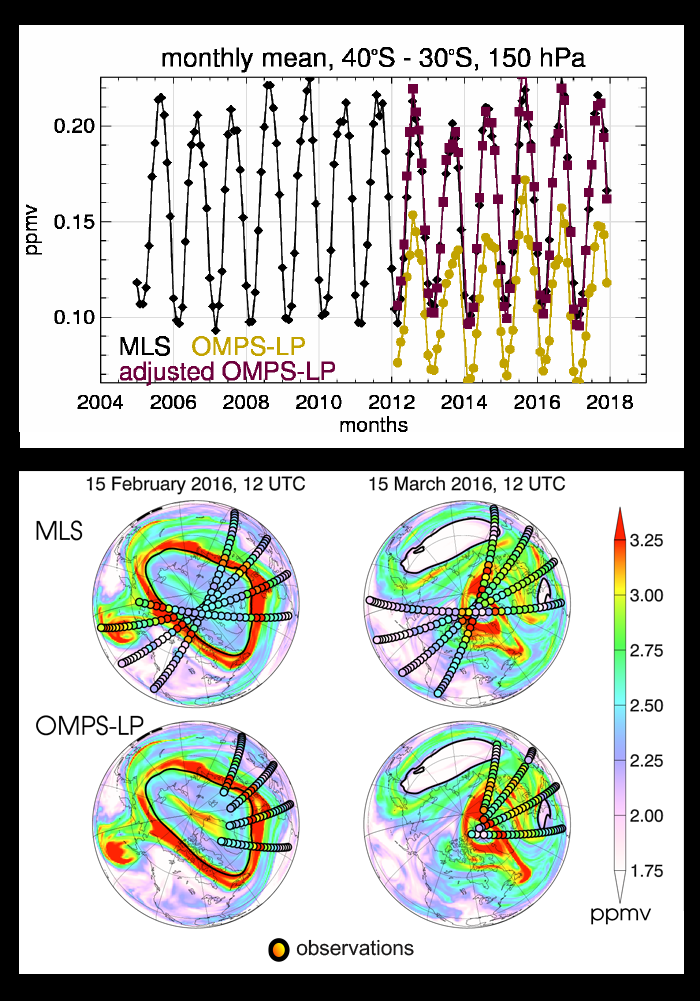Developing an Ozone Climate Data Record from Assimilation of High-Resolution Satellite Observations
The stratospheric ozone layer has begun its road to recovery as the implementation of the Montreal Protocol has led to a gradual decline in the concentrations of anthropogenic ozone depleting substances in the atmosphere. The future trajectory of this recovery depends on the details of the stratospheric chemistry, dynamics, and thermodynamics in the 21st century, and are affected by climate change caused by rapidly increasing atmospheric concentrations of greenhouse gases. Monitoring of the evolution of stratospheric ozone continues to be of great importance to the public as well as to the scientific community.
The GMAO reanalysis products include a detailed global representation of stratospheric ozone spanning several decades. These products use data assimilation to propagate satellite ozone observations in space and time to produce global estimates of ozone at high spatial and temporal resolution. The current GMAO reanalysis, MERRA-2, assimilates ozone profiles from the Microwave Limb Sounder (MLS) onboard NASA’s Aura satellite, a NASA research instrument that has provided a long and stable record of stratospheric composition since late 2004 to the present. The Ozone Mapping and Profiler Suite Limb Profiler (OMPS‐LP) has not yet been used in any atmospheric reanalyses. OMPS-LP is a joint NASA-NOAA instrument currently flying on the Suomi-NPP satellite (2012-present). The planned future OMPS-LP missions on the Joint Polar Satellite System 2, 3, and 4 are expected to extend the stratospheric ozone record well into the 2030s. While both instruments are limb sounders, they operate on different principles. MLS measures microwave thermal emissions of the atmosphere, from which concentrations of various gases are derived. On the other hand, the OMPS-LP utilizes the scattering of solar light by ozone and aerosols.
 Observations (Top): Systematic differences between MLS and OMPS-LP ozone can be corrected by applying a simple adjustment to the OMPS-LP data.
Observations (Top): Systematic differences between MLS and OMPS-LP ozone can be corrected by applying a simple adjustment to the OMPS-LP data.
Assimilation (Bottom): Maps of ozone concentrations at the 480-K potential temperature surface (approximately 19 km above the sea level) from assimilation of MLS and OMPS-LP observations during the 2016 winter and spring.
This work demonstrates that assimilation of ozone profiles from MLS can be extended into the future using data from OMPS-LP. As the two instruments employ very different measurement techniques, some systematic biases between them exist and have been quantified. We show that the relative bias between MLS and OMPS-LP can effectively be corrected by applying a simple adjustment to the OMPS-LP observations, without affecting the observed ozone variability and leading to a continuous record useful for studies of long-term ozone distributions and trends.
Reference:
Wargan, K., Kramarova, N., Weir, B., Pawson, S., & Davis, S. M. (2020). Toward a reanalysis of stratospheric ozone for trend studies: Assimilation of the Aura microwave limb sounder and ozone mapping and profiler suite limb profiler data. Journal of Geophysical Research: Atmospheres, 125, e2019JD031892. https://doi.org/10.1029/2019JD031892

